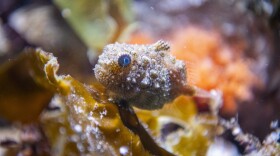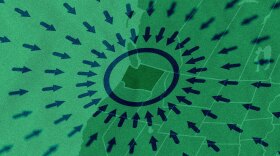Six bright orange 3D-printed statues of innovators in science, technology, engineering and math (STEM) are on view in Seattle. They’re all women from the Pacific Northwest – part of a new exhibit at the Pacific Science Center called “Science for Everyone.”
The statues look down over the main galleries of the Science Center, utilizing a loft space that had been closed during the pandemic. They’re a highlight of a display dedicated to the pursuit of equity and inclusion in STEM careers. The six statues, selected from a larger group of 125 statues, are from a national initiative called "IF/THEN," short for the mantra: "if she can see it, she can be it."
“It's a wonderful initiative that's all about inspiring girls and women in science, technology, engineering, and math,” said Cailee Smith, who developed the local exhibit.
Behind her, kids explored a play area devoted to STEAM careers, which includes art in the mix. Huge blue blocks and foam noodles invite a physical approach to problem solving. The day's challenge: how would you design a rollercoaster? Smith created the exhibit to show how the scientific process happens every day, all around us.
“Even just asking a question or being curious about how something works. That's really the heart of what science is,” she said.
She said the Science Center also has a Tinker Tank Makerspace, where anyone can come experiment with a playful approach to problem solving.
The show in the loft lays out in striking displays the inequalities that remain in scientific fields. For example, it shows that less than a quarter of all engineering degrees went to women in 2021. And less than 9% of all STEM degrees went to women of color.
That disparity has real-world consequences.
“The people at the table determine what questions are being asked – and we need a multitude of questions from diverse perspectives to be asked,” said Isabelle Heyward, the Science Center’s director of exhibits.
She said STEM fields need to catch up and include a demographic mix more representative of society at large.
“To make sure that the experimentation and the critical thinking that we're applying doesn't just represent those multitude of perspectives, but [that] it also serves those multitude of perspectives and lived experiences.”
The "Science is for Everyone" exhibit at Pacific Science Center is expected to stay up at least through 2024. The bright orange sculptures from the IF/THEN initiative belong to the innovators they depict and will be on display in Seattle until June.







